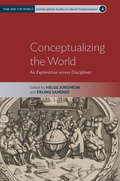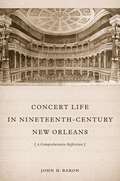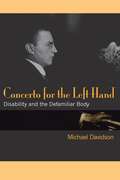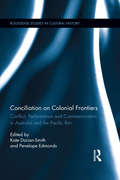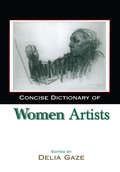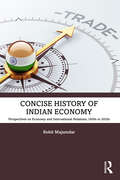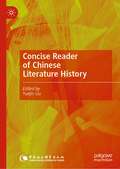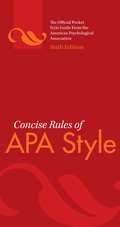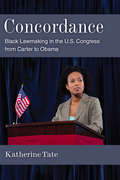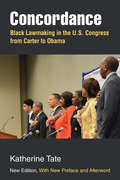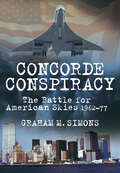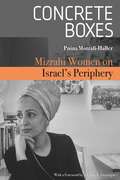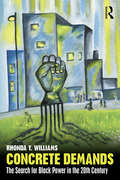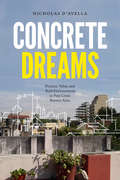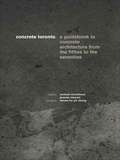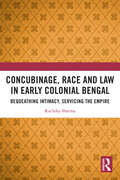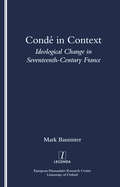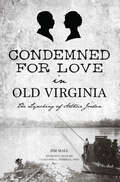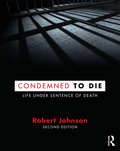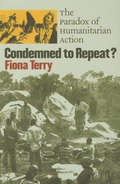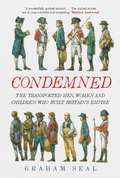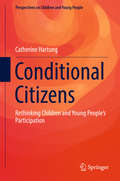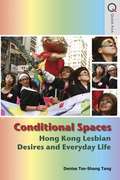- Table View
- List View
Conceptualizing the World: An Exploration across Disciplines (Time and the World: Interdisciplinary Studies in Cultural Transformations #4)
by Helge Jordheim Erling SandmoWhat is—and what was—“the world”? Though often treated as interchangeable with the ongoing and inexorable progress of globalization, concepts of “world,” “globe,” or “earth” instead suggest something limited and absolute. This innovative and interdisciplinary volume concerns itself with this central paradox: that the complex, heterogeneous, and purportedly transhistorical dynamics of globalization have given rise to the idea and reality of a finite—and thus vulnerable—world. Through studies of illuminating historical moments that range from antiquity to the era of Google Earth, each contribution helps to trace the emergence of the world in multitudinous representations, practices, and human experiences.
Conceptualizing the World: An Exploration across Disciplines (Time and the World: Interdisciplinary Studies in Cultural Transformations #4)
by Helge Jordheim Erling SandmoWhat is—and what was—“the world”? Though often treated as interchangeable with the ongoing and inexorable progress of globalization, concepts of “world,” “globe,” or “earth” instead suggest something limited and absolute. This innovative and interdisciplinary volume concerns itself with this central paradox: that the complex, heterogeneous, and purportedly transhistorical dynamics of globalization have given rise to the idea and reality of a finite—and thus vulnerable—world. Through studies of illuminating historical moments that range from antiquity to the era of Google Earth, each contribution helps to trace the emergence of the world in multitudinous representations, practices, and human experiences.
Concert Life in Nineteenth-Century New Orleans: A Comprehensive Reference
by John H. BaronDuring the nineteenth century, New Orleans thrived as the epicenter of classical music in America, outshining New York, Boston, and San Francisco before the Civil War and rivaling them thereafter. While other cities offered few if any operatic productions, New Orleans gained renown for its glorious opera seasons. Resident composers, performers, publishers, teachers, instrument makers, and dealers fed the public's voracious cultural appetite. Tourists came from across the United States to experience the city's thriving musical scene. Until now, no study has offered a thorough history of this exciting and momentous era in American musical performance history. John H. Baron's Concert Life in Nineteenth-Century New Orleans impressively fills that gap.Baron's exhaustively researched work details all aspects of New Orleans's nineteenth-century musical renditions, including the development of orchestras; the surrounding social, political, and economic conditions; and the individuals who collectively made the city a premier destination for world-class musicians. Baron includes a wide-ranging chronological discussion of nearly every documented concert that took place in the Crescent City in the 1800s, establishing Concert Life in Nineteenth-Century New Orleans as an indispensable reference volume.
Concerto for the Left Hand: Disability and the Defamiliar Body
by Michael DavidsonConcerto for the Left Hand is at the cutting edge of the expanding field of disability studies, offering a wide range of essays that investigate the impact of disability across various art forms---including literature, performance, photography, and film. Rather than simply focusing on the ways in which disabled persons are portrayed, Michael Davidson explores how the experience of disability shapes the work of artists and why disability serves as a vital lens through which to interpret modern culture. Covering an eclectic range of topics---from the phantom missing limb in film noir to the poetry of American Sign Language---this collection delivers a unique and engaging assessment of the interplay between disability and aesthetics. Written in a fluid, accessible style, Concerto for the Left Hand will appeal to both specialists and general audiences. With its interdisciplinary approach, this book should appeal not only to scholars of disability studies but to all those working in minority art, deaf studies, visual culture, and modernism. Michael Davidson is Professor of American Literature at the University of California, San Diego. His other books include Guys Like Us: Citing Masculinity in Cold War Poetics and Ghostlier Demarcations: Modern Poetry and the Material World.
Conciliation on Colonial Frontiers: Conflict, Performance, and Commemoration in Australia and the Pacific Rim (Routledge Studies in Cultural History #34)
by Penelope Edmonds Kate Darian-SmithSpanning the late 18th century to the present, this volume explores new directions in imperial and postcolonial histories of conciliation, performance, and conflict between European colonizers and Indigenous peoples in Australia and the Pacific Rim, including Aotearoa New Zealand, Hawaii and the Northwest Pacific Coast. It examines cultural "rituals" and objects; the re-enactments of various events and encounters of exchange, conciliation and diplomacy that occurred on colonial frontiers between non-Indigenous and Indigenous peoples; commemorations of historic events; and how the histories of colonial conflict and conciliation are politicized in nation-building and national identities.
Concise Dictionary of Women Artists
by Gaze DeliaThis book includes some 200 complete entries from the award-winning Dictionary of Women Artists, as well as a selection of introductory essays from the main volume.
Concise History of Indian Economy: Perspectives on Economy and International Relations,1600s to 2020s
by Rohit MajumdarThis book presents a concise economic history of India from 1600 to the mobile economy of the twenty-first century. It examines political events, social history, and economic developments across the world through the years to showcase how India has navigated its economic past, present, and future, and shaped events that for years controlled the Indian economy. This volume covers a range of important themes, which include: • Medieval fiscal systems, and the European surge in India; • The impact of the British Industrial Revolution on India; English interventionism and policies; the imperialistic economy and its impact; • Indian economy and nationalist movement in the nineteenth and early-twentieth century; the Great Depression and its global consequences; • Gandhiism and ‘mass nationalism’; Independence and Partition; the impact of the World Wars; the inter-war economy; the rise of the dollar, and other key global trends; • The Cold War and India; • Constitutional remedies, nation-building and industrial policies; food security, the Green Revolution, and the power politics of 1970s; • Liberalization, privatization, and globalization in the 1990s; and • The economy of war and peace, India–China relations, and current trends in political economy. The book offers a lucid and insightful narrative of how the economy unfolded in India., It will interest readers of Indian history, economic history, and South Asian history and other general readers.
Concise Reader of Chinese Literature History
by Yuejin LiuThis book includes the history of Chinese literature before 1949. It firstly outlines the development process of Chinese literature and basic features and then discusses them according to the literary genre, for the literature of each era. This book gathers established scholars in the field and presents their latest research in the Chinese literature history studies. Moreover, it has included the literature history of different nationalities in the history of China and the records of folk literature history, reflecting literature from different classes. In the limited space of this book, the writers who have been loved by the Chinese people for three thousand years are discussed, such as Qu Yuan, Tao Yuanming, Li Bai, Du Fu, Su Shi, Xin Qiji, Yuan Haowen, Nalan Xingde, and so on. Careful elaborations are made on each writer together with quotations and analysis of their work.
Concise Rules Of APA Style
by American Psychological Association StaffThis text offers writing and formatting standards for students, teachers, researchers, and clinicians working in the field of psychology. It provides complete guidance on the rules of style that are critical for clear communication.
Concordance: Black Lawmaking in the U.S. Congress from Carter to Obama
by Katherine TateDuring the height of the civil rights movement, Blacks were among the most liberal Americans. Since the 1970s, however, increasing representation in national, state, and local government has brought about a more centrist outlook among Black political leaders. Focusing on the Congressional Black Caucus (CBC), Katherine Tate studies the ways in which the nation's most prominent group of Black legislators has developed politically. Organized in 1971, the CBC set out to increase the influence of Black legislators. Indeed, over the past four decades, they have made progress toward the goal of becoming recognized players within Congress. And yet, Tate argues, their incorporation is transforming their policy preferences. Since the Clinton Administration, CBC members--the majority of whom are Democrats--have been less willing to oppose openly congressional party leaders and both Republican and Democratic presidents. Tate documents this transformation with a statistical analysis of Black roll-call votes, using the important Poole-Rosenthal scores from 1977 to 2010. While growing partisanship has affected Congress as a whole, not just minority caucuses, Tate warns that incorporation may mute the independent voice of Black political leaders.
Concordance: Black Lawmaking in the U.S. Congress from Carter to Obama (The Politics of Race and Ethnicity)
by Katherine TateDuring the height of the civil rights movement, Blacks were among the most liberal Americans. Since the 1970s, however, increasing representation in national, state, and local government has brought about a more centrist outlook among Black political leaders. Focusing on the Congressional Black Caucus (CBC), Katherine Tate studies the ways in which the nation’s most prominent group of Black legislators has developed politically. Organized in 1971, the CBC set out to increase the influence of Black legislators. Indeed, over the past four decades, they have made progress toward the goal of becoming recognized players within Congress. And yet, Tate argues, their incorporation is transforming their policy preferences. Since the Clinton Administration, CBC members—the majority of whom are Democrats—have been less willing to oppose openly congressional party leaders and both Republican and Democratic presidents. Tate documents this transformation with a statistical analysis of Black roll-call votes, using the important Poole-Rosenthal scores from 1977 to 2010. While growing partisanship has affected Congress as a whole, not just minority caucuses, Tate warns that incorporation may mute the independent voice of Black political leaders.
Concorde Conspiracy: The Battle for American Skies 1962-77
by Graham M SimonsAn innovation in aviation development, Concorde was the subject of political rivalry, deceit and treachery from its very inception. After their failure to be the first nation to develop a jet airliner for transatlantic flight or to send spacecraft into space, the US Government was adamant that they would beat other nations to the goal of supersonic flight and so development of the SST began. However, with McNamara and Shurcliff’s negative attitudes to the project, it was soon killed off. Thus began the ‘if we cannot do it, neither can you’ attitude towards other countries’ efforts for supersonic flight. This is the story of ten years of behind-the-scenes political intrigue, making use of inside information from two American presidents and the Federal Aviation Authority, as well as recently declassified papers from the CIA and President Kennedy on how the Americans planned to destroy Concorde and their own American SST. Lavishly illustrated with black and white and colour images throughout, Concorde Conspiracy is a must read for any enthusiast on supersonic flight and anyone who enjoys a real-life conspiracy.
Concrete Boxes: Mizrahi Women on Israel's Periphery (Raphael Patai Series in Jewish Folklore and Anthropology)
by Pnina Motzafi-Haller Virginia R DominguezConcrete Boxes: Mizrahi Women on Israel’s Periphery offers a rich depiction of contemporary life in one marginalized development town in the Israeli Negev. Placing the stories of five women at the center, author Pnina Motzafi-Haller depicts a range of creative strategies used by each woman to make a meaningful life within a reality of multiple exclusions. These limitations, Motzafi-Haller argues, create a "concrete box," which, unlike the "glass ceiling" of the liberal feminist discourse, is multi-dimensional and harder to break free from. As the stories unfold, the reader is introduced to the unique paths developed by each of five women in order to keep their families and community together in the face of the stigmatic and hegemonic narratives of Israelis who seldom set foot in their social and geographic periphery. Motzafi-Haller’s ethnography includes the daily struggles of Nurit, a single mother with a drug-addicted partner, in her attempt to make ends meet and escape social isolation; Ephrat’s investment in an increasingly religious-observant lifestyle; the juggling acts of Rachel, who develops a creative mix of narratives of self, using middle-class rhetoric in reimagining a material reality of continued dependence on the welfare system; the rebellious choices of Esti, who at thirty-five, refuses to marry, have children, or keep a stable job, celebrating against all odds a life of gambling, consumption beyond her means, and a tight and supportive social network; and the life story of Gila, who was born in Yeruham but was able to "escape" it and establish herself in middle-class life as a school principal. Taken together, these intimate narratives ask us to consider both the potential and limitations of post-colonial feminist insights about the manner in which knowledge is produced. Concrete Boxes offers sustained reflection about Israeli reality rarely documented in scholarly work and a thought-provoking theoretical exploration of the ways in which individual agency encounters social restrictions and how social marginality is reproduced and challenged at the same time.
Concrete Demands: The Search for Black Power in the 20th Century
by Rhonda Y. WilliamsBetween the 1950s and 1970s, Black Power coalesced as activists advocated a more oppositional approach to fighting racial oppression, emphasizing racial pride, asserting black political, cultural, and economic autonomy, and challenging white power. In Concrete Demands, Rhonda Y. Williams provides a rich, deeply researched history that sheds new light on this important social and political movement, and shows that the era of expansive Black Power politics that emerged in the 1960s had long roots and diverse trajectories within the 20th century. Looking at the struggle from the grassroots level, Williams highlights the role of ordinary people as well as more famous historical actors, and demonstrates that women activists were central to Black Power. Vivid and highly readable, Concrete Demands is a perfect introduction to Black Power in the twentieth century for anyone interested in the history of black liberation movements.
Concrete Dreams: Practice, Value, and Built Environments in Post-Crisis Buenos Aires
by Nicholas D'AvellaIn Concrete Dreams Nicholas D&’Avella examines the changing social and economic lives of buildings in the context of a construction boom following Argentina's political and economic crisis of 2001. D&’Avella tells the stories of small-scale investors who turned to real estate as an alternative to a financial system they no longer trusted, of architects who struggled to maintain artistic values and political commitments in the face of the ongoing commodification of their work, and of residents-turned-activists who worked to protect their neighborhoods and city from being overtaken by new development. Such forms of everyday engagement with buildings, he argues, produce divergent forms of value that persist in tension with hegemonic forms of value. In the dreams attached to built environments and the material forms in which those dreams are articulated—from charts and graphs to architectural drawings, urban planning codes, and tango lyrics—D&’Avella finds a blueprint for building livable futures in which people can survive alongside and even push back against the hegemony of capitalism.
Concrete Toronto: A Guide to Concrete Architecture from the Fifties to the Seventies
by Michael Mcclelland Graeme StewartAfter World War II, concrete became increasingly popular as a building medium around the world. Brutalism, the fashion for plain, heavy design, reigned. Toronto was particularly affected. The city has concrete buildings of all stripes international landmarks, metropolitan infrastructure and even the single family home. Hundreds of these structures were built, including Viljo Revells groundbreaking New City Hall, John Andrews seminal Scarborough College and the record-smashing CN Tower. Toronto is a city cast in concrete. However, as architectural fashion has shifted from postmodernism to the glass-and-steel neomodernism of today, these concrete structures have been ignored, misunderstood and, in some cases, demolished. Concrete Toronto acts as a guide to the city's extensive concrete heritage. A diverse group of experts has been assembled to re-examine the uniqueness and value of these buildings. Included are the insights of many of the original concrete architects, university faculty, local practitioners, journalists and industry experts. Together they explore the past and future of Toronto's concrete buildings. Included is a wealth of new and archival photos, drawings, interviews, articles, as well as case studies of Toronto's major concrete architecture.
Concubinage, Race and Law in Early Colonial Bengal: Bequeathing Intimacy, Servicing the Empire
by Ruchika SharmaThis book analyzes the domestic relations which British men came to establish with native Indian women in early colonial Bengal. It provides a fresh look into the history of imperial expansion and colonial encounters by studying the large number of wills left by the British men who came in an official or economic capacity to India. It closely engages with these wills, considering them as unique personal records. These documents, where the men penned down details of their native mistresses, give a glimpse of what their lives, interpersonal relationships, household objects, and everyday affairs were like. The volume highlights how commonplace such non-marital cohabitation was and constructs the social history of these connections. It looks at issues of theft, violence, rape, bequeathment, and property rights which the women had to contend with, and also studies some of the early experiences of the mixed-race children who were a product of these relationships. A unique look into the asymmetrical but fascinating history of interracial households in early colonial Bengal, this book will be of interest to students and researchers of history, women’s studies, gender studies, colonial law, colonial travel writing, minority studies, colonialism, imperialism, and South Asian studies.
Conde in Context: Ideological Change in Seventeeth-century France
by Mark Bannister"Louis II de Bourbon (1621-86), known as Le Grand Conde, stood alongside Richelieu and Mazarin as one of the key figures who shaped the reign of Louis XIV. In response to profound upheavals in their world, his contemporaries looked to him to satisfy their need for a hero. Originally the warrior-hero par excellence, Conde was redefined by successive generations as the ideal subject of the absolutist state, as the epitome of civilized behaviour and, finally, as the exemplar of the triumph of faith over reason. In this first detailed study in English of Le Grand Conde's significance for his contemporaries, Mark Bannister reveals the complexity of the ideological patterns forming and reforming in seventeenth-century France, and the perennial need to believe in the existence of an iconic figure, incarnating new values as they emerge."
Condemned
by Scott ChristiansonIn the annals of American criminal justice, two prisons stand out as icons of institutionalized brutality and deprivation: Alcatraz and Sing Sing. In the 70 odd years before 1963, when the death sentence was declared unconstitutional in New York, Sing Sing was the site of almost one-half of the 1,353 executions carried out in the state. More people were executed at Sing Sing than at any other American prison, yet Sing Sing's death house was, to a remarkable extent, one of the most closed, secret and mythologized places in modern America. In this remarkable book, based on recently revealed archival materials, Scott Christianson takes us on a disturbing and poignant tour of Sing Sing's legendary death house, and introduces us to those whose lives Sing Sing claimed. Within the dusty files were mug shots of each newly arrived prisoner, most still wearing the out-to-court clothes they had on earlier that day when they learned their verdict and were sentenced to death. It is these sometimes bewildered, sometimes defiant, faces that fill the pages of Condemned, along with the documents of their last months at Sing Sing. The reader follows prisoners from their introduction to the rules of Sing Sing, through their contact with guards and psychiatrists, their pleas for clemency, escape attempts, resistance, and their final letters and messages before being put to death. We meet the mother of five accused of killing her husband, the two young Chinese men accused of a murder during a robbery and the drifter who doesn't remember killing at all. While the majority of inmates are everyday people, Julius and Ethel Rosenberg were also executed here, as were the major figures in the infamous Murder Inc., forerunner of the American mafia. Page upon page, Condemned leaves an indelible impression of humanity and suffering.
Condemned for Love in Old Virginia: The Lynching of Arthur Jordan (True Crime)
by Jim HallWhen romance was met with murder…Arthur Jordan and Elvira Corder were young and unafraid, but their love was doomed. He was black, she was white, and this was Virginia in 1880. When Elvira became pregnant, the couple fled Fauquier County to live in Maryland. But her father found them and recruited neighbors to help kidnap them. Four nights later, a mob dragged Arthur from the county jail in Warrenton and lynched him. Elvira, taken to a hotel in Williamsport, Maryland, was never heard from again. Stories of lynching are all too common in the postbellum South, but this one tells a unique tale of a couple who were willing to sacrifice everything to be together--and did.Author Jim Hall tells a classic tale of forbidden love, one of hope crushed by hate.
Condemned to Die: Life Under Sentence of Death
by Robert JohnsonCondemned to Die is a book about life under sentence of death in American prisons. The great majority of condemned prisoners are confined on death rows before they are executed. Death rows typically feature solitary confinement, a harsh regimen that is closely examined in this book. Death rows that feature solitary confinement are most common in states that execute prisoners with regularity, which is to say, where there is a realistic threat that condemned prisoners will be put to death. Less restrictive confinement conditions for condemned prisoners can be found in states where executions are rare. Confinement conditions matter, especially to prisoners, but a central contention of this book is that no regimen of confinement under sentence of death offers its inmates a round of activity that might in any way prepare them for the ordeal they must face in the execution chamber, when they are put to death. In a basic and profound sense, all condemned prisoners are warehoused for death in the shadow of the executioner. Human warehousing, seen most clearly on solitary confinement death rows, violates every tenet of just punishment; no legal or philosophical justification for capital punishment demands or even permits warehousing of prisoners under sentence of death. The punishment is death. There is neither a mandate nor a justification for harsh and dehumanizing confinement before the prisoner is put to death. Yet warehousing for death, of an empty and sometimes brutal nature, is the universal fate of condemned prisoners. The enormous suffering and justice caused by this human warehousing, rendered in the words of the prisoners themselves, is the subject of this book.
Condemned to Repeat?
by Fiona TerryHumanitarian groups have failed, Fiona Terry believes, to face up to the core paradox of their activity: humanitarian action aims to alleviate suffering, but by inadvertently sustaining conflict it potentially prolongs suffering. In Condemned to Repeat?, Terry examines the side-effects of intervention by aid organizations and points out the need to acknowledge the political consequences of the choice to give aid. The author makes the controversial claim that aid agencies act as though the initial decision to supply aid satisfies any need for ethical discussion and are often blind to the moral quandaries of aid. Terry focuses on four historically relevant cases: Rwandan camps in Zaire, Afghan camps in Pakistan, Salvadoran and Nicaraguan camps in Honduras, and Cambodian camps in Thailand. Terry was the head of the French section of Medecins sans frontieres (Doctors Without Borders) when it withdrew from the Rwandan refugee camps in Zaire because aid intended for refugees actually strengthened those responsible for perpetrating genocide. This book contains documents from the former Rwandan army and government that were found in the refugee camps after they were attacked in late 1996. This material illustrates how combatants manipulate humanitarian action to their benefit. Condemned to Repeat? makes clear that the paradox of aid demands immediate attention by organizations and governments around the world. The author stresses that, if international agencies are to meet the needs of populations in crisis, their organizational behavior must adjust to the wider political and socioeconomic contexts in which aid occurs.
Condemned: The Transported Men, Women and Children Who Built Britain's Empire
by Graham SealA powerful account of how coerced migration built the British Empire In the early seventeenth century, Britain took ruthless steps to deal with its unwanted citizens, forcibly removing men, women, and children from their homelands and sending them to far-flung corners of the empire to be sold off to colonial masters. This oppressive regime grew into a brutal system of human bondage which would continue into the twentieth century. Drawing on firsthand accounts, letters, and official documents, Graham Seal uncovers the traumatic struggles of those shipped around the empire. He shows how the earliest large-scale kidnapping and transportation of children to the American colonies were quickly bolstered with shipments of the poor, criminal, and rebellious to different continents, including Australia. From Asia to Africa, this global trade in forced labor allowed Britain to build its colonies while turning a considerable profit. Incisive and moving, this account brings to light the true extent of a cruel strand in the history of the British Empire.
Conditional Citizens: Rethinking Children and Young People’s Participation (Perspectives on Children and Young People #5)
by Catherine HartungThis book challenges readers to recognise the conditions that underpin popular approaches to children and young people's participation, as well as the key processes and institutions that have enabled its rise as a global force of social change in new times. The book draws on the vast international literature, as well as interviews with key practitioners, policy-makers, activists, delegates and academics from Japan, South Africa, Brazil, Nicaragua, Australia, the United Kingdom, Finland, the United States and Italy to examine the emergence of the young citizen as a key global priority in the work of the UN, NGOs, government and academia. In so doing, the book engages contemporary and interdisciplinary debates around citizenship, rights, childhood and youth to examine the complex conditions through which children and young people are governed and invited to govern themselves. The book argues that much of what is considered 'children and young people's participation' today is part of a wider neoliberal project that emphasises an ideal young citizen who is responsible and rational while simultaneously downplaying the role of systemic inequality and potentially reinforcing rather than overcoming children and young people's subjugation. Yet the book also moves beyond mere critique and offers suggestive ways to broaden our understanding of children and young people's participation by drawing on 15 international examples of empirical research from around the world, including the Philippines, Bangladesh, the United Kingdom, North America, Finland, South Africa, Australia and Latin America. These examples provoke practitioners, policy-makers and academics to think differently about children and young people and the possibilities for their participatory citizenship beyond that which serves the political agendas of dominant interest groups.
Conditional Spaces: Hong Kong Lesbian Desires and Everyday Life
by Denise Tse-Shang TangThis book offers an in-depth sociological study on Hong Kong lesbian and transgender lesbian subjectivities and their materialization within multiple spaces. Based on thirty life history interviews, the author attempts to map the complex relations between lesbian subjectivities and spatialities as they emerge, develop, interact and negotiate with each other in their everyday lives. Drawing upon theories on cultural studies, feminism, postcolonialism, urban sociology and queer theory, this book positions Hong Kong as a late capitalist city and neoliberal economy, to bring the notion of sexuality and spaces together in a theoretical exercise in order to focus on the forces that determine the conditions and possibilities for the materialization of lesbian and transgender lesbian desires and identities. Tang investigates social relations within certain spaces and make linkages between a living room, a busy street, a classroom, a church congregation, a workplace and a queer film festival. Hong Kong women with lesbian desires and transgender lesbians can be understood as exclusionary to some spaces but participatory in the constant development of new sites where their needs and intimate desires are met. Tang concludes that a preliminary analysis of spaces in Hong Kong can be rooted in a physical sense but also proposes conditional spatiality as a theoretical concept to understand the emergence and disappearance of spaces.
